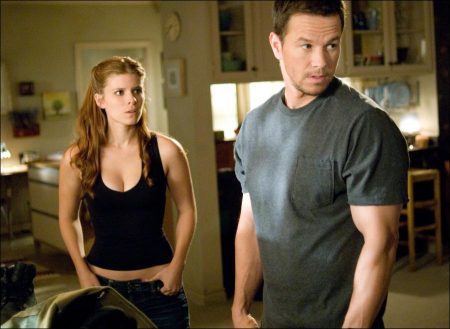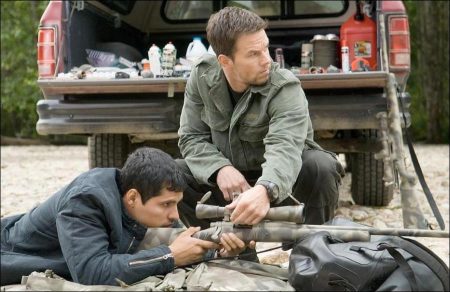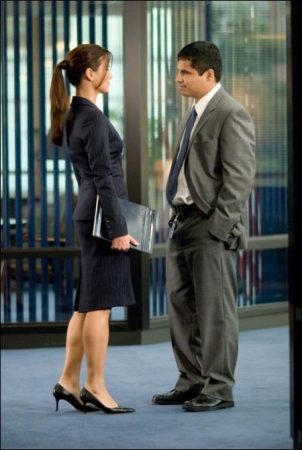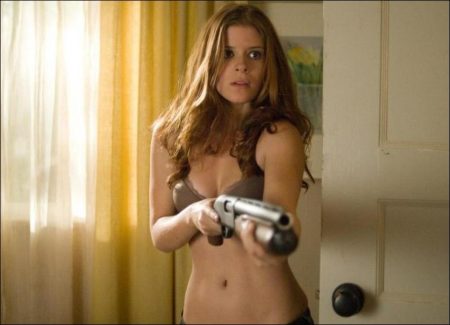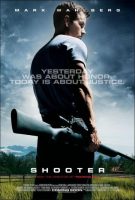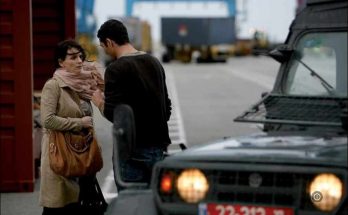Tagline: Yesterday was about honor, today is about justice.
Shooter movie storyline. From Antoine Fuqua, the director of “Training Day,” and starring Academy Award and Golden Globe nominee Mark Wahlberg (“The Departed,” “Invincible”) comes an edgy, non-stop action thriller about an honorable and brilliant marksman who finds himself in an unthinkable situation: framed as a Presidential assassin.
Plunged into a shocking vortex of terror and conspiracy, the rogue shooter discovers the race is on to prove his innocence even as he is pursued by every law enforcement agency in the country, as well as a shadowy organization on a relentless manhunt aimed at destroying the secrets he has uncovered.
In a gripping action performance, Mark Wahlberg stars as Bob Lee Swagger, a former Marine scout sniper and disgruntled American hero who thought he had walked away from the job forever after a devastating betrayal. Now, despite having sequestered himself in a stunning but remote mountain hideaway, Bob is approached by retired Colonel Isaac Johnson (Danny Glover), who tells him the country desperately needs him. As Johnson tells it, an assassination attempt on the President of the United States is imminent and only Swagger’s lethal skills and savvy expertise in long-range ballistics can halt the threat.
Swagger reluctantly agrees one last time to serve his country – but what he doesn’t know is that the entire mission is a set-up by a dark government cabal with its own agenda. By the time Swagger realizes the event has been rigged, it’s too late. Suddenly, he finds himself in the headlines as the lone gunman who tried to shoot the President. Hunted at every turn, with nowhere to hide and no one to help him except a mystified woman he’s just met (Kate Mara) and a novice FBI agent risking his career (Michael Peña), Swagger is in a desperate battle which will put everything he knows to the test.
An Honorable Man, A Hijacked Government
The core American value of honor has become a scarce commodity in today’s politically complicated and increasingly corrupt world – but it lies at the very heart of Bob Lee Swagger, the sniper hero of “Shooter,” who finds himself in the middle of his worst possible nightmare after he is framed as a Presidential assassin. Trusted by no one, hunted by an angry, frightened nation and haunted by his own past, Swagger must use every military, ballistic and psychological skill he has, and then some, to not only survive but try to restore the honor that means so much to him. Yet far more than his personal honor is at stake. His battle is also for the honor of the country he loves, as he finds himself caught in a dark web of deceit that reaches into the very heart of the U.S. government – which has been hijacked by a secret association bound only by its hunger for power and willingness to violate the public trust.
“Bob Lee Swagger is a phenomenal American character who brings to mind cinema heroes like John Wayne and other classic Western characters,” observes the film’s producer, Lorenzo di Bonaventura, whose many hit films range from the classic sci-fi thriller “The Matrix” to the hit action-comedy “Ocean’s Eleven” and Antoine Fuqua’s Oscar-winning “Training Day.” “Bob has that same uncompromising quality. His sense of right and wrong, and how he feels about what is justice and what isn’t justice, are things you can really emotionally connect with inside this exciting conspiracy thriller.”
The character of Bob Lee Swagger first came to the fore in the best-selling novel Point of Impact by Pulitzer Prize-winning author Stephen Hunter, who also happens to be a film critic for The Washington Post. A blistering page-turner, the novel won widespread acclaim for its smartly plotted, authentically scary, edge-of-your-seat suspense, with Bob Lee Swagger declared “a thinking man’s Rambo” by Publishers Weekly. The book’s popularity launched a trilogy about Swagger that continued with the novels Black Light and Time to Hunt.
Hunter (who has a small role in “Shooter”) always suspected Bob Lee Swagger could be a great movie character – but only if the story was approached correctly. “Bob Lee Swagger is one of those extremely talented, dedicated, unbelievably courageous men that the movies have somehow never gotten right, even though they use him all the time,” comments Hunter. “But I wanted him to be portrayed as he really would be – to show what’s great and inspirational about him, but at the same time, to capture his humanity and his complexity, his doubts and fears, as well. To me, the story asks: what is loyalty, what is honor, what is courage?”
Those are the same questions that compelled screenwriter Jonathan Lemkin (“Lethal Weapon 4,” “The Devil’s Advocate”) to take a crack at bringing Hunter’s tale of a good man caught in a dark web of lies and corruption to the screen. Many other accomplished writers had tried before, unsuccessfully, but Lemkin found his own creative way to adapt the 550-page novel filled with the minute details of a sniper’s life and thought process into a tight, lean 120-page script.
In doing so, Lemkin’s inspiration came not only from Hunter’s carefully drawn characters and insider’s understanding of men of action, but from another compelling source: the beloved, blockbuster, man-on-the-run conspiracy thrillers of the 1970s, which reflected the profound institutional distrust of those times, yet seemed palpably relevant right now.
“We took a lot of time looking at early conspiracy movies and thinking about how to move that kind of style into the present day,” explains Lemkin. “I don’t know how many times we saw `Three Days of the Condor’ or `The Parallax View’ – but one of the things we were really trying to do with this story was to revisit that kind of classic conspiracy thriller in a very contemporary and current way.”
Diving deeper into the writing process and the mind of Bob Lee Swagger, Lemkin even signed himself up for a course in sniper training. “I went out and laid in the dirt with the Marines at a private sniper base which actually trains the contractors who are now in Iraq,” he explains. “I learned to shoot, learned to crawl through the bushes, learned to clean a weapon and learned to, hopefully, think a little bit like a sniper. I also spent time with the FBI and did a lot of research into field medicine, which is how I learned, for example, that sugar has been used to fight infections since the Napoleonic Wars.”
With his wide-ranging research, most of all what Lemkin keyed into is what drives a man like Swagger. “Bob Lee Swagger never does something because someone tells him to do it or because he thinks he should do it for someone else. He truly believes in honor and living by his own code,” he summarizes.
Ultimately, the authenticity and breakneck pace of Lemkin’s screenplay would attract the interest of one of today’s most daring and increasingly versatile screen stars: Mark Wahlberg, who recently won widespread acclaim and awards for his performance as a hard-nosed undercover detective in Martin Scorsese’s “The Departed.” The script also drew a director who is becoming known for his affinity and skill with intense, character-driven action: Antoine Fuqua, who drew international acclaim with the searing police drama “Training Day,” which garnered Denzel Washington the Academy Award for Best Actor.
Having previously worked with Fuqua on “Training Day,” Lorenzo di Bonaventura was convinced that the rising director would make a great match with this white-knuckle twist on the politically savvy conspiracy thriller. “Antoine brings that level of intensity which this movie requires,” says di Bonaventura. “As a director, he has a very uncompromising view. With Antoine, when the story is emotional, it’s going to be really emotional, when it’s violent, it’s going to be really violent, if it’s mysterious, it’s very, very mysterious. The whole experience of the movie is heightened.”
For Fuqua, the story had a combination of qualities that he felt would add up to one of his biggest challenges yet. “This project had all the elements for me: conspiracy, government corruption, action and, most of all, Mark Wahlberg,” he says. “I thought Jonathan Lemkin had really nailed the screenplay. It’s got a great plot, great characters and also great scope. It’s big and it’s fun and I also believe it’ll make audiences think. You really have to pay attention because there are so many plot twists and turns.”
A Shooter Who Becomes a Target
Driving the action of “Shooter” is Bob Lee Swagger, one of the most devastatingly accurate snipers in the entire world and a man who has spent his entire existence taking on perilous missions and risking his life for what he believes. But now, this stoic hero with deadly abilities will have to turn all his smarts, skills and knowledge towards saving himself – and uncovering the conspiracy that has left him as the patsy in an assassination attempt on the President of the United States.
Bringing Swagger to life is an actor who was able to bring both authentic athletic prowess and simmering psychological intensity to the role: Mark Wahlberg, who has risen to become one of Hollywood’s most sought-after actors with his standout performances in such films as “Boogie Nights,” “Three Kings,” “The Perfect Storm,” “Invincible” and most recently has garnered numerous awards including Golden Globe and Oscar nominations for “The Departed.”
Wahlberg was drawn to the role precisely because he knew it would be a new and exciting challenge. “`Shooter’ was both a physical challenge and a huge mental challenge,” he says. “It’s a really smart movie that also has a lot of action. This is a character who has to go through so much just to prove his innocence and open people’s eyes. His story is an amazing ride.”
For Wahlberg, the heart of the character was his shattered belief system – and the journey he goes through to restore his sense of being able to make a difference in a corrupted world. “This guy has dedicated his whole life to fighting for his country and fighting for freedom, but he’s also been betrayed,” the actor explains. “Still, once they sell him the idea that innocent people and our President could be in danger, he sits up in his chair and says `which way do you want me to go?’ Then, when he’s betrayed again, he’s rightfully overcome with anger. He’s cut off from everything and everyone, he’s in this impossible situation, but if he’s going to attain his goal he has to start to see himself as not all alone in the world anymore.”
The subtle yet relentlessly suspenseful portrait Wahlberg provides is of a man whose quiet, reserved, stolid exterior is about to boil over into a rage for the truth. All of the filmmakers were impressed with Wahlberg’s unsinkable devotion to bringing Bob Lee Swagger to life in such a multilayered way. Says Lorenzo di Bonaventura, who has previously worked with Wahlberg on four other films: “Mark has incredible concentration. When he’s committed to something, he’ll jump in and just do it and get it right – and he won’t stop until he does that. He brought a lot of veracity to Bob Lee Swagger because he put in all of the work leading up to it.”
Di Bonaventura continues: “What I also love about Mark is he’s not afraid to be a man. He’s almost a throw-back to the leading men of another era in that way.”
While Wahlberg threw himself with typical gusto into the rigorous physical training necessary to carry out the film’s complex and realistic action sequences, he was equally focused on finding his way past Bob Lee Swagger’s incredible strength to touch upon the vulnerability within. This is revealed in the scenes in which Swagger connects with the only person left in the world to whom he discovers he can confide – his former partner’s feisty widow, Sarah, played in the film by rising newcomer Kate Mara.
“Sarah is basically the only person on earth who can help Bob,” notes Wahlberg. “I feel like the chemistry we have together helps to make the movie that much more accessible, even to women, inside this hard core story about survival. It’s not really a lust thing between them. They have this deeper understanding and they need each other in any number of different ways. Their relationship is extremely innocent and caring, in contrast to everything else that’s happening to him. This is just a character with an incredible arc.”
Wahlberg Goes to Sniper School: About Training as a Shooter
Key to the suspense of “Shooter” is the most true-to-life, painstakingly accurate portrayal of a military sniper yet seen on film. To achieve this, Mark Wahlberg had to commit himself to an intensive “boot camp,” learning and carefully cultivating some of the extraordinary skills that set the very best shooters, like Bob Lee Swagger, apart, including a Zen-like ability to control one’s emotions, fears and nerves while dialing in a laser-like focus that allows for near-impossible shots to hit their marks dead-on.
Wahlberg came to the production with the advantage of already being a highly trained athlete with exceptional physical strength, endurance and coordination. But to hone him into a seasoned shootist – the kind who could hit a target 1,000 meters away with dead aim – the production recruited one of the nation’s true elite in the field: U.S. Marine scout sniper Patrick Garrity, who has served both in vital deployments overseas and as a specialized trainer for snipers.
Jumping into the task with a typical gung ho spirit, Garrity constructed a not-so-basic training in field skills for Wahlberg that put even the famously tough actor through his paces. The idea was to not only teach Walhberg to shoot well but to give him a sense of the kind of mental and physical commitment, not to mention heart, the extremely dangerous missions of a sniper scout require. His boot camp began at Front Sight Firearms Training Institute near Las Vegas, Nevada, where Wahlberg followed a nerve-testing training protocol that included jumping off the largest zip line tower in America. For Wahlberg, the training was revelatory.
“Front Sight is basically the most elaborate weapons training facility that I’ve ever seen,” says Wahlberg. “At one point, I had on 130 pounds of equipment, was carrying this huge sniper rifle and had to walk out on this little thin beam a couple of hundred feet in the air. A few years ago, these are things that I would have loved to have done, but now I’m a parent and have a lot more to live for!”
He adds: “The training definitely opened my eyes to the importance of being safe and smart as opposed to being reckless like I once was.”
As a battle-tested Marine, Patrick Garrity isn’t easily impressed but Wahlberg quickly won his respect with his hard work and tenacity. “I think Mark is a very good fit for this role,” says the experienced scout sniper. “He’s even got the young military look with the chiseled face and the right attitude. When he first showed up, he was a little loose, maybe not knowing what to expect. But I set up a two-day training course for him and he came ready with a great work ethic. He picks up everything extremely fast and it made my job a lot easier.”
Watching the training, director Antoine Fuqua was equally awed by Wahlberg’s natural talent and unusual level of commitment. “It was amazing to watch Mark go through the training and, especially, to do such accurate shooting,” recalls Fuqua. “He has so much natural ability. At first, there was some concern because Mark is a left-hander and, since most weapons aren’t made for a left-handed shooter, he had to learn how to shoot right-handed for the movie – which is tough – and also switch between right-handed shooting and left-handing shooting. But Mark was amazing. He hit a few bull’s-eyes right away the first day.”
Knowing that Wahlberg could handle it, Garrity designed training as intensive as anything undertaken before by an actor preparing for such a role. He started by giving Wahlberg a basic history lesson about Marine scout snipers – who have made a difference in many American battles by providing precision fire on selected targets. Garrity then quickly moved into the nitty-gritty, teaching Wahlberg the use of different shooting positions, how to manipulate the prismatic scope for extreme long-range shooting, how to judge the effects of the wind on a shot and all the many vital factors that go into producing keen marksmanship.
One area on which Garrity focused with Wahlberg is what’s known as “rapid bolt manipulation.” He explains: “That’s one thing that Marine scout snipers have to do – they take their shot, rapidly manipulate the bolt and get right back on target. It was important for Mark to be able to portray Swagger’s proficiency with weapons systems by getting that right.”
The two men also worked on another shooting essential: breathing skills. “I basically took him through my routine of getting down behind the rifle, getting a good position, going through your breathing cycle, relaxing your eye and starting the trigger press,” comments Garrity. “Once that trigger press is released – racking the bolt, chambering another round and getting right back on target – it’s almost like a dance step or art. You can really tell when somebody knows what they’re doing with how they get set up for their shot. One of the key factors that happens before a sniper takes a shot is getting into the breathing cycle. The more you breathe, the more oxygen you’re putting into your blood cells, which allows you to relax and slows your heart rate down.”
Garrity further worked on extreme distance shooting with Wahlberg, which is one of Bob Lee Swagger’s specialized skills. “I took him to an unknown distance range in the middle of the desert – we call it Sniper’s Point – and started him at close targets. Finally, we walked out to 900 yards. I think he missed the first one and after the first miss, made contact on the next one. Same thing at 1,100 yards, which is about ten football fields. I was pretty excited that I could get somebody, in two days, to be able to hit an 1,100-yard man-sized target. Mark got on the phone and started calling all of his friends,” laughs Garrity, “to tell them, `You won’t believe what I just did. I shot something a thousand yards away!’”
Leaving no stone unturned, Garrity also educated Wahlberg about the so-called ghillie suits used by pro snipers to mimic the natural vegetation for camouflage. “When you become a scout sniper,” explains Garrity, “the first thing you do is learn to make a ghillie suit.” Ultimately, Garrity would use his intimate personal knowledge of ghillie suits to help accurately construct some of the suits used in the film.
While training at Front Sight, Wahlberg realized that Garrity’s continued input would be invaluable during production of “Shooter,” and convinced the producers to hire the Marine in a bigger capacity as the film’s military technical advisor. By closely modeling Bob Lee Swagger on Garrity’s knowledge and comportment, Wahlberg would lend an even deeper authenticity to the role.
Garrity was quick to accept the challenge. “It was my chance to show on film what scout snipers really do. There’s been a lot of myth and lore that go along with what people think about scout snipers, so I hope that what people see in `Shooter’ is a lot more accurate.”
Hunting the Shooter: About the Supporting Cast
Joining Mark Wahlberg in “Shooter” is a supporting cast of beloved veteran actors and promising newcomers – in roles ranging from those who are hunting Bob Lee Swagger to those few who come to help him on his journey to find the truth about why he was set up as an assassin.
The only person to believe Swagger’s story inside the law enforcement community is, ironically, a rookie FBI agent who first runs into Swagger during his escape from the assassination scene – and winds up the worse for wear. Despite having been embarrassed by Swagger, Agent Nick Memphis can’t help but feel that something doesn’t quite add up about the FBI’s insistence that Swagger was the lone gunman. Playing Memphis as he goes from skeptical agent to Swagger’s protégé is Michael Peña, who has quickly risen as a versatile young star with roles in such films as the Oscar®-winning “Crash,” “World Trade Center” and “Babel.”
Peña jumped at the chance to work with director Antoine Fuqua, in part because he considers “Training Day” one of his all-time favorite movies. “I thought Antoine did an amazing job with Denzel Washington and Ethan Hawke in `Training Day,’” marvels the actor. “I must have seen the movie five times. I just love passionate directors, which is Antoine. On the set, you had any questions whatsoever, he was more than happy to give you a lot more insight. He really connected with this story.”
Like Wahlberg, Peña dove into the role, hoping to bring as much authenticity to it as possible. He immersed himself in FBI offices in both Los Angeles and Philadelphia and also underwent his own intensive sniper training for the climactic scenes in which he and Swagger take on a swarm of mercenaries by using their skills and their wits.
Meanwhile, in a departure from his more sympathetic characters in such films as the “Lethal Weapon” series and the recent, acclaimed “Dreamgirls,” Danny Glover stars as Swagger’s chief nemesis – the shadowy Colonel Isaac Johnson, who recruits Swagger with patriotic words, then betrays him in the worst way possible. For the filmmakers, seeing Glover in the surprising role of one of the masterminds of a government conspiracy was part of the excitement of the film. “Danny has brought so much to so many different kinds of movies, but this is a different kind of role for Danny,” observes producer di Bonaventura. “It allows Danny to be a little bit more edgy. We were allowed to use Danny’s strengths in a way that turns your expectation of who he is on its head a little bit, which is always fun.”
Bringing a feminine element to “Shooter” is Kate Mara, a young actress whose career has rocketed from television to the big screen, as the confused young widow who gives safe harbor, and ultimately tenderness, to Bob Lee Swagger. Mara was immediately drawn to the screenplay. “I couldn’t put it down,” she recalls, “it was just too suspenseful.”
She was also strongly drawn to the character of Sarah Fenn, a lonely, widowed schoolteacher who takes a risk on trusting a stranger who has put her in a very dangerous position. “I like that she’s a really strong Southern woman and she’s very different from anyone I’ve played before,” says the actress. “It’s hard for her when Swagger just shows up in her life, because he brings back all these demons and reminds her of the husband she lost. She’s sort of thrown into a tough dilemma – but she can’t help but care about Swagger and feel for him.”
Mara was also compelled by the opportunity to work with Antoine Fuqua. “He thinks of wonderful things you never would,” she says of the director. “He always knows what he wants you to do with the character, but he has this wonderful way of making you feel like you’ve come up with it yourself.”
The filmmakers were especially excited about the chemistry that seemed to flow electrically between Mara and Wahlberg. Says di Bonaventura: “Swagger and Sarah have suffered tragedy around the same man so their common bond, their common wound, is a man who stands figuratively between the two of them. What’s fascinating about watching this relationship blossom is how they deal with the fact that there’s this man in the middle of them that they both cared deeply about, and it’s a hesitation for both characters to cross that barrier. There’s a lot of emotional texture to their relationship and it’s really a tribute to Mark and Kate because they took it to its fullest extent on an emotional level.”
Rounding out the cast are character actor Elias Koteas (“Zodiac”) in the role of menacing ISA offical Jack Payne, British actress Rhona Mitra (“The Number 23”) as FBI assistant Alourdes Galindo, international star Rade Sherbedgia (“Say It in Russian,” “24”) as Michael Sandor and veteran star Ned Beatty as the aging U.S. Senator who plays a major role in the film’s climactic moments.
For di Bonaventura, casting Beatty was another of the film’s coups. “I can remember some of the first movies I saw him in,” remarks the producer. “He hasn’t been seen for a while on the screen, so there was an extra pleasure in having him in the film – and he’s an unbelievably fine actor.”
Shooting the Shooter: About the Production
Filled wall-to-wall with car chases, foot chases, shoot-outs and high-wire outdoor action sequences, the production of “Shooter” was rife with the kinds of logistical challenges that director Antoine Fuqua relishes. With locations spanning from British Columbia, where the breathtaking, alpine environment provided an awe-inspiring backdrop, to the major U.S. cities of Washington, D.C., Philadelphia and Baltimore – and with intricate stunts and choreographed action required at every turn – the undertaking was massive.
Throughout, Fuqua worked closely with a team of visual artists noted for their keen skills in creating visceral, electrifying action, including director of photography Peter Menzies, Jr. (“Lara Croft: Tomb Raider,” “Die Hard With a Vengeance”) and production designer Dennis Washington (“The Fugitive”).
Some of the film’s most visually stunning and exciting moments come at the climax atop a frozen glacier, where Swagger has a rendezvous, at long last, with the men who set up him up to take the fall. This sequence was shot high atop Rainbow Glacier, near the resort town of Whistler, British Columbia – a gorgeously primal locale, but one not necessarily well-suited for filmmaking.
Accessible only by helicopter, the first issue was simply getting the cast and crew to the glacier for the five-day shoot. “Just getting there was incredibly complicated,” explains di Bonaventura. “The choppers can only take five or four people at a time and we had to have 70 to 80 people up there, plus a lot of heavy equipment, so there was constant ferrying around, and there are only a certain number of hours pilots can fly.”
He continues: “We had to factor in how much gear each person would require to survive for several days up on the side of this glacier. We also had to figure out how to provide bathroom facilities in the middle of nowhere, and how to keep our cast from getting frozen up. Of course, we knew the weather could quickly turn fierce and dangerous at any minute, so we kept our fingers crossed. It was a really amazing adventure.”
For Antoine Fuqua, the location had to work because it was just too perfect not to use to its fullest potential. “I kept saying `I’ve gotta shoot on this glacier, I’ve gotta shoot on this glacier,’” Fuqua recalls. “It’s just so spectacular. When you’re there, above the clouds and on top of nothing but ice, it’s like being in another world. Visually, for me, I just couldn’t see doing it anywhere else.”
Still, the director put in a lot of extra effort to assure the cast and crew’s safety, even in such unpredictable conditions. “You have to realize that, once you’re helicoptered up, you’re literally stuck on this glacier which is filled with serious dangers,” he explains. “Storms can come in at any time and you have to watch out for all the crevasses. But safety was our biggest focus. People were always tethered and we took our time. Every shot moved 50 to 75 percent slower than normal.”
The camerawork itself was quite daring on the glacier. “I actually had to get on a helicopter and use the helicopter as a dolly quite a bit to literally move around,” Fuqua continues. “It was very challenging to get the helicopter balanced on the ground without hitting the ice. Also, because of the glacier, your perspective can be completely thrown off. What you think is far away is really close and what you think is really close is far away. You’re up on this white sheet of ice all day, your eyes start to burn and it’s hard to keep things in perspective. So you really have to focus that much more.”
Elaborate scenes utilizing helicopters, numerous gun-toting mercenaries and several large explosions also took place in Mission, BC, about ninety minutes from Vancouver, which stood in for Bob Lee Swagger’s mountain-top ranch. Breathtaking as it was, the location became known as “Mission: Impossible” for its constant barrage of obstacles and challenges ranging from constant shifts in weather to bone-breaking terrain. It was here that stunt coordinator John Stoneham and the visual effects team also did some of their finest work, carefully rigging several massive, napalm-style explosions that ratchet up the intensity and suspense of the film even further.
Also in Canada, the historic desert community of Ashcroft, BC was used as a stand-in for scenes that take place in the Horn of Africa, near Eritrea. The arid terrain, surrounded by mountains, provided the perfect setting for production designer Dennis Washington to re-create a U.S. military camp in the small African nation of Djibouti.
As successful as the Canadian portion of the shoot was, Fuqua was eager to move on to the U.S. locations. “Personally, I love shooting on location because it puts me in real space,” says the director. Among the highly recognizable locales seen in “Shooter” are the Capital Mall, the Reflection Pool in front of the Capital and Constitution Avenue in Washington, D.C. and Independence Hall in Philadelphia.
Throughout the shoot in the U.S., Fuqua credits the FBI’s cooperation with lending even more striking authenticity to the film. “The FBI was incredible to us,” remarks Fuqua. “In Philadelphia, the FBI just opened up their doors to us, which I didn’t think would happen, especially after 9/11. They let us roam all around the offices, we met the ASAC [Assistant Special Agent In Charge], we met the Violent Crime Squad. A couple of guys at the FBI who used to be Secret Service actually got up every day when we were shooting in Philadelphia at six in the morning and came to the set to tell us what was right and what was wrong about what we were doing, on their own, just to help. We also had the opportunity to shoot in front of Independence Hall, which we couldn’t have done without the FBI, whose offices are right across the street from Independence Hall.”
While the intricate logistics added further intensity and excitement to the production, for Fuqua the bottom line always came back to the characters – and the journey of Bob Lee Swagger to find his way through an impossible situation to some kind of justice. Fuqua summarizes: “Shooting the big sequences in this film was sometimes like going into battle. You had to coordinate everything perfectly – the explosions, keeping people safe, making it look cool, using the best angles and shots, all of that. But as important as all of that is, the real heart of the excitement still comes down to the performances of the actors.”
Shooter (2007)
Directed by: Antoine Fuqua
Starring: Mark Wahlberg, Michael Pena, Danny Glover, Kate Mara, Elias Koteas, Rhona Mitra, Rade Sherbedgia, Ned Beatty, Rebecca Toolan, Mackenzie Gray, David Bloom
Screenplay by: Jonathan Lemkin, Stephen Hunter
Production Design by: Vance Lorenzini
Cinematography by: Peter Menzies
Film Editing by: Conrad Buff, Eric A. Sears
Cosutume Design by: Ha Nguyen
Set Decoration by: Johanne Hubert
Art Direction by: Jeremy Stanbridge
Music by: Mark Mancina
MPAA Rating: R for strong graphic violence and language.
Distributed by: Paramount Pictures
Release Date: March 23, 2007
Views: 200
